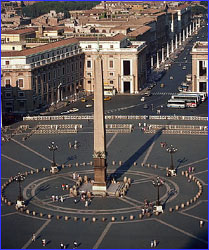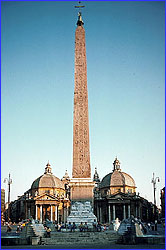
|
 |
 |
Rome back to A World of Obelisks Location: Piazza S. Giovanni, Laterano, Rome, Italy Pharaoh: Tuthmosis III (reigned 1504-1450 B.C.) Height: 105.6 feet Weight: 455 tons Story: The so-called Lateran obelisk is the largest standing obelisk in the world. Its inscriptions state that while it was begun during the reign of Tuthmosis III, it lay in the craftsmen's workshops for 35 years and was finally erected by his grandson Tuthmosis IV. The only single obelisk ever put up in Karnak Temple (obelisks usually came in pairs), it was removed under the orders of the Roman emperor Constantine (A.D. 274-337), who hoped to raise it in his new capital at Constantinople. He died before the obelisk ever left Egypt, and his son and successor Constantius (A.D. 317-361) had it taken to Rome, where it was re-erected in the Circus Maximus. At some unknown date and by some unknown cause, the obelisk fell. It was not until the 16th century that Pope Sixtus V ordered a search for the monolith. It was found, in three pieces, some 23 feet down in the former Circus Maximus. On August 3, 1588, after more than a year of effort, the Lateran obelisk was raised in the Piazza San Giovanni in Laterano, where it has stood ever since, a Christian cross at its apex.  Location: St. Peter's Square, Vatican, Rome
Location: St. Peter's Square, Vatican, RomePharaoh: Unknown Height: 83 feet Weight: 331 tons Story: This obelisk, like two others in Rome, is uninscribed, and no one knows where it originally came from or who created it. It is known that Emperor Augustus ordered it erected in the Julian Forum in Alexandria, where it stayed until A.D. 37. That year, the Emperor Caligula had it removed to the Vatican Circus in Rome. According to the Egyptologist Labib Habachi, "Legend has it that in the Vatican Circus innumerable Christians, including St. Peter, were put to death and that the reason this obelisk was not later overturned as were all the others in Rome was that it was looked upon as the last witness to the martyrdom of St. Peter." In the 16th century, the Pope Sixtus V directed the obelisk to be re-erected in the collonnaded square before the Basilica of St. Peter, where it remains to this day. During its relocation, workers carefully inspected the metal globe that had stood atop the obelisk since Roman times. They were looking for the remains of Caesar, which were reputedly cached there, but they found only dust. After the successful re-erection, triumphant Romans carried the chief engineer, Domenico Fontana, on their shoulders all the way to his home.  Location: Piazza del Popolo, Rome, Italy
Location: Piazza del Popolo, Rome, ItalyPharaoh: Seti I (reigned 1318-1304 B.C.) Height: 75 feet Weight: 263 tons Story: Seti I decorated three sides of this obelisk, while his son Ramses II carved the fourth and erected the obelisk in the sun temple at Heliopolis, a capital of ancient Egypt. In inscriptions on one side of the monolith, Seti I describes himself as "the one who fills Heliopolis with obelisks that their rays may illuminate the Temple of Re." Ramses II, one of history's greatest self-aggrandizers, styled himself as one who made "monuments as innumerable as the stars of heaven. His works join the sky. When Re shines, he rejoices because of [the obelisks] in his temple of millions of years." In 10 B.C., the obelisk was re-erected at the Circus Maximus in Rome to celebrate Augustus' conquest of Egypt. Sometime later it toppled, to be resurrected in the 16th century under Pope Sixtus V. In 1589, it became the centerpiece of the Piazza del Popola in Rome, where three major avenues of the city converge. Location: Monte Citorio, Rome, Italy Pharaoh: Psammetikos II (reigned 595-589 B.C.) Height: 72 feet Weight: 230 tons Story: Psammetikos II, the third king of the 26th Dynasty (666-524 A.D.), erected this obelisk at Heliopolis near Cairo. Many of the inscriptions have eroded away, though a list of the king's many names remains: "The Golden Horus, 'beautifying the Two Lands,' beloved of Atum, lord of Heliopolis; the King of Upper and Lower Egypt, Neferibre, beloved of Re-Harakhti; the son of his own body, who seizes the White Crown and who unites the Double Crown, Psammetikos, beloved of the Souls of Heliopolis." Like the obelisk at the Piazza del Popolo, this obelisk was re-erected in Rome in 10 B.C. to commemorate the emperor Augustus' victories in Egypt. It remained there, in the Campus Martius, for many centuries before falling over in the 10th or 11th century. It wasn't until the 18th century that it was finally restored and re-erected at Monte Citorio. Back to A World of Obelisks Photos: (1,2) Corbis/Michael S. Yamashita. Explore Ancient Egypt | Raising the Obelisk | Meet the Team Dispatches | Pyramids | E-Mail | Resources Classroom Resources | Site Map | Mysteries of the Nile Home Editor's Picks | Previous Sites | Join Us/E-mail | TV/Web Schedule About NOVA | Teachers | Site Map | Shop | Jobs | Search | To print PBS Online | NOVA Online | WGBH © | Updated November 2000 |